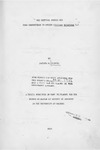| dc.description.abstract | This thesis reports on experimental work carried out
on Irish potato ( Solanum tuberosum L.) during the 1980-81
short rains and 1981 long rains. The work was conducted at
Kabete, Faculty of Agriculture Field Station, located at an
altitude of 1850 m and within 1° 15* S and 36° 44'E. The
average annual rainfall for the area is about 925 mm.
The objective of the study was to determine the stage
at which weed competition affects potato growth and tuber yield
most. This was done by looking at the effect of weed competition
throughout the growing season on potato plant growth and tuber
yield, both at various stages of growth, and at final harvest,
tuber dry matter content and leaf area development.
A randomised complete block design was used with four
replicates. The treatments were 16 weeding frequencies
combined fa ctoria lly with two potato varieties - Anett and B53
(Roslin Eburu), making a total of 32 treatment combinations.
In the 1980 short rains, due to low weed density and
vigorous initial crop growth, there was no significant
reduction in the final tuber yield by a delay in weeding from
the 15th up to the 30th day. However, a further delay from
the 30th up to the 45th day caused a fin al tuber yield reduction
of 207. in Anett and 167. in B53. During the long rains of
1981, where weed density was very high, a delay in weeding
from the 15th up to the 30th day caused a decrease in the
final tuber yield of 187. in Anett and 167. in B53. A further
i i i
delay from the 30th up to the 45th day caused a yield
reduction of 32 and 387. in Anett and B53 respectively.
Leaf area index showed a similar trend to the one shown
by the final tuber yield. A delay in weeding up to the 45th
day caused a significant drop in leaf area index during the
two seasons.
The percent tuber dry matter was not significantly
affected by weed competition in the two seasons.
Anett out yielded B53 during the 1980 short rains. It
yielded a greater proportion of ware than B53,whose tuber yield
was predominantly seed size grade.
Anett developed a peak leaf area earlier but maintained
it for a shorter period than B53 in both seasons. B53 had a
more developed haulm, attained peak leaf area later but
maintained i t for a longer duration.
B53 tubers had a significantly higher percent dry matter
than Anett.
The c ritic a l weed competition period in potatoes at
Kabete was found to be between the 14th and 45th day after
crop emergence. During this period, the crop was growing
vigorously and any weed competition adversely interfered with
crop growth and tuber yield.
One weeding at 15 days after crop emergence was as good
as clear weeding, giving the highest leaf area and final tuber
yield which also contained' the highest percentage of ware size
tubers. At Kabete, one weeding at 15 days after crop emergence
was therefore found to be enough and anymore weedings appeared
to be an unnecessary addition to the production costs. | en_US |

